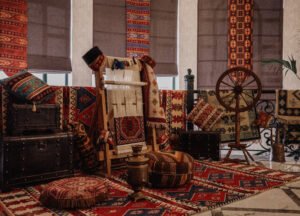A beautifully designed room often feels complete, but what gives it that final, polished touch? More often than not, the secret lies on the floor. Rugs and carpets are far more than just decorative accessories; they are foundational elements that can transform a space. Top interior designers understand this power, consistently using rugs to anchor furniture, define zones, and infuse a room with personality and warmth.
For many, a rug is an afterthought, but it should be a key consideration from the beginning of any design project. A well-chosen rug can tie disparate elements together, add a layer of luxury, and even make a room feel larger or cozier. It has the unique ability to determine the entire atmosphere of a living space.
This guide will explore why rugs are essential in interior design and how they can elevate your home. We’ll also provide expert buying tips to help you find the perfect fit for every room, ensuring your choice is both beautiful and practical.
Why Rugs and Carpets Are Essential in Interior Design
A bare floor can feel cold and uninviting. Rugs and carpets are the solution, offering a host of benefits that go beyond simple aesthetics. They are a critical tool in an interior designer’s kit for several key reasons.
- Define and Anchor Spaces: In open-plan living areas, a rug can create distinct zones, such as a seating area in the living room or a designated dining space. By placing furniture on or around a rug, you anchor the pieces and create a cohesive, grounded look.
- Add Warmth, Comfort, and Luxury: There’s nothing quite like the feeling of a soft, plush rug underfoot. Rugs add a tangible sense of comfort and warmth, making a space more inviting. Materials like wool and silk introduce a touch of luxury that instantly elevates the room.
- Introduce Color, Pattern, and Texture: Rugs are an excellent way to introduce color and pattern into a room without overwhelming it. They can serve as the primary source of a color scheme or add a complementary accent. The texture of a rug—be it a chunky jute or a smooth silk—adds depth and interest to the overall design.
- Provide Practical Benefits: Beyond their visual appeal, rugs offer practical advantages. They help reduce noise by absorbing sound, which is especially useful in homes with hard flooring. They also provide insulation, helping to keep a room warmer in the winter and cooler in the summer.
How Rugs & Carpets Elevate Interior Designs
The right rug doesn’t just complement a room; it elevates it. Here’s how a thoughtfully chosen piece can enhance your interior design.
Create Focal Points
A bold, statement rug can act as a piece of art for your floor. In a minimalist or neutral room, a rug with a vibrant pattern or rich color can become the focal point, drawing the eye and anchoring the entire design.
Add Layers of Luxury
Texture is a key element of sophisticated interior design. Layering different textures creates a rich, complex, and inviting space. A high-pile wool carpet or a lustrous silk rug adds a layer of luxury and dimension that makes a room feel more curated and complete.
Enhance Style Harmony
A rug is the thread that can tie an entire room together. It can connect various pieces of furniture and décor, creating a harmonious and unified look. Whether your style is modern, traditional, or eclectic, the right rug will pull all the elements together seamlessly.
Make Spaces Feel Bigger or Cozier
The size and placement of a rug can manipulate the perception of a room’s size. A large rug that extends under all the furniture can make a space feel bigger and more cohesive. Conversely, a smaller, plush rug can create a cozy, intimate nook within a larger room.
Express Personality
Your home is a reflection of your personality, and a rug is a perfect canvas for self-expression. From artisanal, hand-knotted designs that tell a story of cultural heritage to bold, modern patterns that showcase a contemporary edge, the rug you choose says a lot about your personal style.
Tips to Buy the Perfect Fit
Choosing the right rug can feel daunting, but it doesn’t have to be. Follow these tips from interior designers to select a piece that you’ll love for years to come.
- Measure First: The most common mistake is buying a rug that’s too small. Measure your space and your furniture layout. In a living room, the rug should be large enough for at least the front legs of your sofa and chairs to rest on it.
- Select the Right Material: Consider the room’s function. Wool is durable and soft, making it great for living rooms. Silk is luxurious but more delicate, best for low-traffic areas like bedrooms. Natural fibers like jute and sisal are affordable and durable but can be coarse. Synthetics are often stain-resistant and ideal for high-traffic zones or homes with pets and kids.
- Match Style with Space: Ensure the rug’s style complements your room’s aesthetic. A traditional Persian rug might look out of place in a stark, modern space, while a geometric design could clash with classic furniture. Look for transitional designs if you want to bridge different styles.
- Color & Pattern Balance: Decide if you want your rug to be a neutral foundation or a statement piece. If your furniture and décor are already vibrant, a neutral rug can provide balance. If your room is more subdued, a patterned rug can add a much-needed pop of excitement.
- Lifestyle Consideration: Be realistic about your lifestyle. If you have pets or young children, a high-maintenance white silk rug is probably not the best choice. Opt for durable, easy-to-clean materials in high-traffic areas.
- Think Long-Term: A high-quality, handmade rug is an investment. While it may cost more upfront, a well-crafted piece from a reputable brand like The Ambiente will last for decades, adding timeless elegance to your home.
Room-by-Room Buying Guide
Different rooms have different needs. Here’s a quick guide to choosing rugs for various spaces in your home.
- Living Room Rugs: Opt for a large rug that anchors the main seating area. It should be big enough to fit under the front legs of your sofa and armchairs, creating a unified conversation space.
- Bedroom Rugs: A plush, soft rug is perfect for the bedroom. Place it so that you have a soft landing when you get out of bed. You can place one large rug under the bed or use runners on each side.
- Dining Room Rugs: The rug should be large enough to fit your dining table and chairs, even when the chairs are pulled out. This prevents chairs from catching on the edge of the rug.
- Hallways & Entryways: These high-traffic areas require durable runners. A beautiful runner can make a narrow hallway feel more elegant and welcoming.
- Work Corners: In a multi-functional space, a small rug can help define a work or study zone, separating it visually from the rest of the room.
Find Your Foundation
Rugs and carpets are powerful design tools that do more than just cover your floors. They add comfort, style, and personality, transforming a house into a home. The perfect fit depends on a careful balance of size, material, style, and placement. By investing wisely in a quality rug, you are laying the foundation for an interior that is elegant, comfortable, and truly your own.
Ready to find the perfect piece to elevate your space? Explore The Ambiente’s exclusive collection of handmade rugs, crafted by skilled artisans who blend traditional techniques with contemporary design. For a personalized experience, book a consultation with our interior design experts or visit our Delhi store to see the beauty of our woven wonders firsthand.
Frequently Asked Questions (FAQ)
How do I choose the right size rug for my space?
The general rule is to ensure the rug is proportional to the room and furniture. In living rooms, at least the front legs of your furniture should be on the rug. In dining rooms, the rug should extend about 24 inches beyond the table on all sides. Always measure your space before you buy.
What materials are best for high-traffic areas?
For high-traffic areas like hallways and living rooms, durable materials like wool and high-quality synthetics (such as nylon or polypropylene) are excellent choices. They are resilient, easy to clean, and can withstand heavy footfall.
How do I care for and clean my rug?
Regular vacuuming is essential. For spills, blot the area immediately with a clean cloth. For deep cleaning, professional services are recommended, especially for delicate materials like silk and wool. Rotating your rug every six months also helps to ensure even wear.
Can a rug really change the feel of a room?
Absolutely. A rug can instantly add warmth, define a space, and introduce color and texture. It can make a room feel cozier, more luxurious, or more vibrant, completely altering its ambiance.
What are the latest trends in rug design?
Current trends include rugs with bold, abstract patterns, earthy and neutral tones, and vintage-inspired designs. Layering rugs of different textures and patterns is also a popular technique used by interior designers to add depth and personality to a room.





